|
|
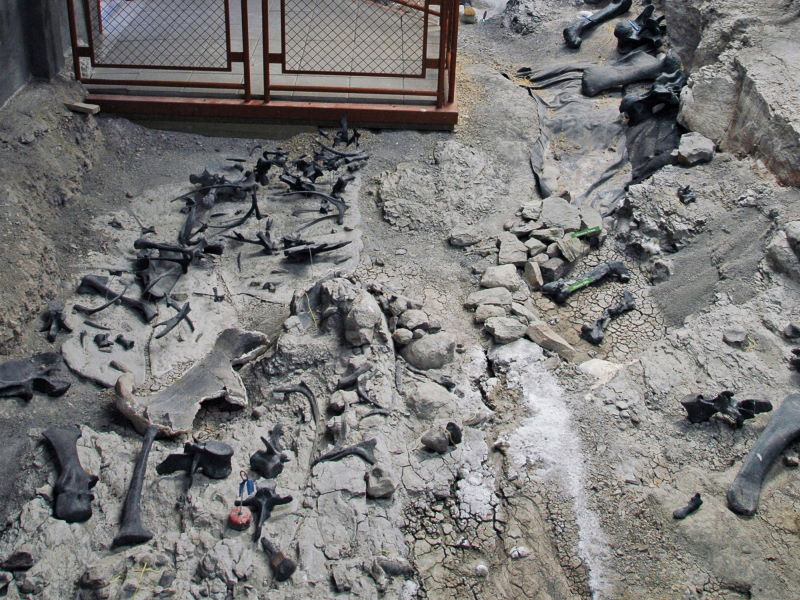
by Ellie Pleasnick, age 12
Utah is known for its preservation of dinosaur fossils. A particular site that stands out is Cleveland-Lloyd dinosaur quarry, a national landmark that is 148 million years old. For decades, scientists have studied this region to understand the Jurassic dinosaur fossils that have been left behind. In particular, they want to understand why the quarry is so packed with carnivorous bones.
The very first excavation at Cleveland-Lloyd occurred in 1928 and was led by scientists from the University of Utah. Ten years later, William Lee Stokes, who studied at Princeton University, led an excavation at the site. Eventually he came to be a chief authority at the bone bed. Many years later, paleontologists continued to excavate the quarry and discovered that more than 75% of the bones found there came from a dinosaur called
Allosaurus fragilis
. This species was able to grow up to 30 feet long, had three large curved claws on each hand, and had sharp teeth. Along with Allosaurus, bones from other dinosaurs like
Marshosarus
and
Stokesaurus
also appeared at the quarry, but in significantly fewer amounts.
Initial hypotheses for the dense concentration of dinosaur fossils in the area involved the idea of a predator trap. Scientists hypothesized that dinosaurs in search of water accidentally stumbled into a drying lake bed. Slowly the dinosaurs sank into the mud and could not escape. Scientists believe this cycle of dinosaurs sinking and dying happened repeatedly over many years. The Allosaurus would come and most likely feast on the trapped dinosaurs, and get stuck themselves, therefore making Allosaurus a large part of the quarry.
[read more]
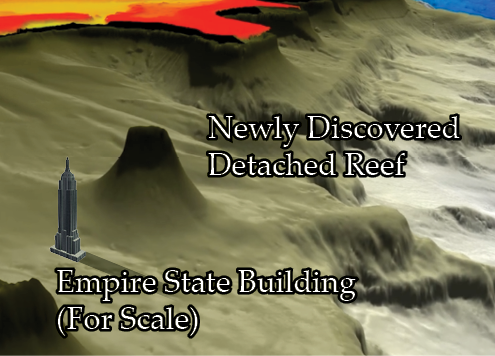
by Nevaeh Powell, age 13
Near the end of October while observing an area near the Great Barrier Reef, scientists found one of the largest underwater structures discovered in over a century: a reef structure made of coral.
The scientists that found the reef were on a year long expedition surveying the seabed around Australia. As the researchers were traveling on the Schmidt Ocean Institute’s research ship, the Falkor, they were using an subaquatic robot called SuBastian. SuBastian used technology that allowed the scientists to explore and create 3D maps of the ocean. As the group was on their journey, they discovered the tower or “detached reef.'' A detached reef is a structure, or tower in this case, that isn't attached to a larger nearby reef but sits alone at the bottom of the sea floor.
The tower is 1,640 feet above the sea floor at its highest point and nearly a mile wide at the bottom. The tower is taller than the Empire State Building, and it's top is just 130 feet below sea level.
[read more]
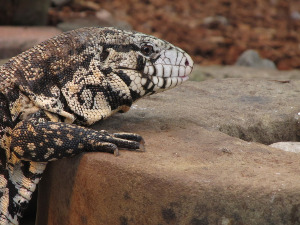
by Ayden Ross, age 14
A dog-sized lizard, the Argentine black-and-white tegu, is rapidly taking over the Everglades National Park. This lizard, native to South America, is spreading throughout South Florida and the southeastern region of the U.S. Biologists are concerned because these lizards will eat almost anything that will fit into their mouths, from berries to small animals such as birds and reptiles, as well as the eggs of animals that nest on the ground such as endangered sea turtles.
These dog-sized lizards can make very calm pets for those who like exotic reptiles. Unfortunately, people have let them loose into the wild where they have bred prolifically. Official estimates of the tegu lizard population in the U.S is unknown, however, a 2018 study conducted by the U.S. Geological Survey stated that, “the entire southeast portion of the United States is at risk.”
Once in the wild, the tegu lizards are able to thrive in regions containing grasslands and in other areas that have a significant amount of rain, such as in hardwood and subtropical pine forests.
[read more]
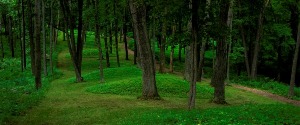
by Hanna Eyobed, age 14
Have you ever been hiking in the Madison area and seen mounds in the ground? Do you know the significance of a mound to Wisconsin’s history?
There are many kinds of mounds built by Native Americans. They can be shaped like panthers, bears, geese, and turtles. Others can be in the shapes of cones or lines. According to the National Park Service, the mounds were built with very little technology. Builders used baskets to gather and carry dirt to the mound location. Then they began pouring the dirt out and proceeded to press the dirt down with their hands and feet. This process took a few days as they would work from morning to night, padding down the dirt to their desired shape.
[read more]
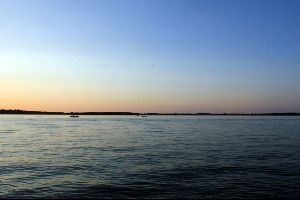
by Sharon Ruiz and Kadjata Bah
On a chilly and cloudy morning, we took a trip to Lake Farm County Park, a section of the Capital Springs Recreation Area, to take a tour of the property and the new Lower Yahara River Trail. The Lower River Trail includes a new boardwalk bridge that stretches over Lake Waubesa, connecting Madison to McFarland. The total distance of the trail is 2.5 miles, and the bridge itself is an impressive mile long. The boardwalk bridge is fully accessible and features fishing piers and scenic outlooks. At the end of the bridge, the tranquility of McDaniel Park awaited us.
We walked back across the bridge to Lake Farm County Park. We soon realized there were many connecting trails for those who enjoy activities such as hiking and cross-country skiing.
This county park is home to the Lussier Family Heritage Center and is host to the largest campground in the county parks system. The park also has three shelters at different points with playgrounds, picnic areas, and volleyball sections. By the first shelter, there is an observation tower that was recently renovated and provides a stunning view of the surrounding area. With to large acres of woodlands, marshes, and prairie, the park is home to many native wildlife species. Two Sandhill cranes attracted our attention on this day.
[read more]
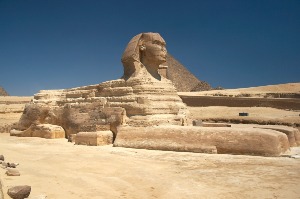
by Destany Jackson, age 13
Ancient Egyptians were skilled mathematicians and architects who built huge stone monuments in honor of their rulers. One type of monument they built for their pharaohs was the pyramid. The most impressive of the ancient monuments were the Egyptian pyramids which were built in Giza.
The Pyramids were built for the pharaohs of the Old Kingdom who ruled from 2686 to 2134 BC. The tombs inside the pyramids were huge and had four walls. The first Egyptian pyramid had stepped sides and was built in Saqqara around 2650 B.C.E. The pyramids built over 100 years later, in Giza, had flat sides. Inside the pyramids were burial chambers and secret passageways. No one really knows why the tombs were built in a pyramid shape. One theory is that the sides were viewed as a stairway to heaven to help pharaohs achieve eternal life.
The Pyramids still stand today. The manual labor needed to construct them was not provided by slaves but by ordinary workers who provided their unskilled service each year when the flooding Nile made it impossible for them to work in the fields.
[read more]
Utah is known for its preservation of dinosaur fossils. A particular site that stands out is Cleveland-Lloyd dinosaur quarry, a national landmark that is 148 million years old. For decades, scientists have studied this region to understand the Jurassic dinosaur fossils that have been left behind. In particular, they want to understand why the quarry is so packed with carnivorous bones.
[read more...]
The fall of the Mayan empire remains a mystery, but today’s scientists believe they’ve found clues to understand how the empire collapsed. For 3000 years, the Mayans lived in Mesoamerica where they made creative structures and built an advanced community. After reaching their peak in power, the empire collapsed in only 150 years.
[read more...]
Near the end of October while observing an area near the Great Barrier Reef, scientists found one of the largest underwater structures discovered in over a century: a reef structure made of coral.
[read more...]
A dog-sized lizard, the Argentine black-and-white tegu, is rapidly taking over the Everglades National Park. This lizard, native to South America, is spreading throughout South Florida and the southeastern region of the U.S. Biologists are concerned because these lizards will eat almost anything that will fit into their mouths, from berries to small animals such as birds and reptiles, as well as the eggs of animals that nest on the ground such as endangered sea turtles.
[read more...]
Coastal sand crumbles at the human touch but is powerful enough to form barrier islands. Have you ever wondered how this is possible?
[read more...]
Have you ever been hiking in the Madison area and seen mounds in the ground? Do you know the significance of a mound to Wisconsin’s history?
[read more...]
Ancient Egyptians were skilled mathematicians and architects who built huge stone monuments in honor of their rulers. One type of monument they built for their pharaohs was the pyramid. The most impressive of the ancient monuments were the Egyptian pyramids which were built in Giza.
[read more...]
On a chilly and cloudy morning, we took a trip to Lake Farm County Park, a section of the Capital Springs Recreation Area, to take a tour of the property and the new Lower Yahara River Trail. The Lower River Trail includes a new boardwalk bridge that stretches over Lake Waubesa, connecting Madison to McFarland. The total distance of the trail is 2.5 miles, and the bridge itself is an impressive mile long. The boardwalk bridge is fully accessible and features fishing piers and scenic outlooks. At the end of the bridge, the tranquility of McDaniel Park awaited us.
[read more...]
For years, scientists have recorded volcanic eruptions. One such explosion, the biggest in recorded history, is known as “The Big Bang at Krakatoa.”
[read more...]
From 1789 to 1799, the people of France led their country in a revolution that marked a huge turning point in European history and led to the end of the French Monarchy. The period included the
Reign of Terror
which lasted for from 1793 to 1794.
[read more...]
In Ancient Egypt, around 2686 to 2181 B.C.E., the Egyptians built the Pyramids of Giza. These pyramids held the tombs of pharaohs and many secrets for thousands of years. Now that the chambers of the deceased pharaohs are opened, a number of ancient Egyptian secrets have been revealed.
[read more...]
Death Valley is a desert located between California and Nevada. It is the hottest place on planet Earth, the highest temperatures in Death Valley can reach up to 134 degrees Fahrenheit.
[read more...]
The forests of Madagascar, an island located off the east coast of Africa, are host to many unique plants and animals. Madagascar was first discovered by humans approximately two thousand years ago. Now, less than ten percent of the lush forest remains – the sole habitat of many indigenous animals.
[read more...]
Many may have heard the name “Malala Yousafzai” before, but some might not know who this powerful young woman is. Yousafzai is a very important activist who has helped girls in Pakistan fight for their educations.
[read more...]
With wind whipping through the sails of her ship, Laura Dekker set off on a once-in-a-lifetime adventure. She had a dream of sailing around the world, and she wanted badly to accomplish it. At the age of 14, Dekker set out to achieve her dream and began to sail around the world by herself.
[read more...]
Grown in Africa, Asia, and Central and South America, the sisal plant is truly amazing. It has had a major impact on the economy of Tanzania, where thousands are employed to produce sisal.
[read more...]
You probably know the legend of the majestic, antlered deer that live in the North Pole. You may even know that reindeer exist outside of Christmas stories. But did you know that there are actually people who live among reindeer?
[read more...]
California’s Yosemite National Park is a very large and beautiful place. Home to thousands of animal and plant species, the park boasts awesome mountains, scenic valleys, and clear rivers.
[read more...]
One of the most fearsome leaders of the early 5th century was not a war general or a dictator. No, he was the short, illegitimate son of an Irish king. His story is often overlooked in history books and little is known about his personal life, but his legacy lives on along with his name: he is Niall of the Nine Hostages.
[read more...]
Back in the 1800s, many Irish people emigrated to Wisconsin. To this day, their descendants continue to live throughout the state and influence its culture.
[read more...]
The Galapagos are a group of oceanic islands made up of 15 main islands, 42 islets, and 26 rocks and reefs. Located in the Pacific Ocean, the islands were created when lava rose from the sea bed. The region also has a marine reserve of 79,900 square kilometers.
[read more...]
The Great Barrier Reef, at the bottom of the Pacific Ocean, is an astounding symbol of life and beauty. Home to thousands of creatures, it is currently under threat of destruction, however, and could ultimately become a representation of how the world can kill a natural-made beauty.
[read more...]
Could you imagine walking over 1600 kilometers, alone and in the cold, harsh weather of the Antarctic? This past year, a man almost completed this nearly impossible task.
[read more...]
Did you know that several generations of the giant forest hog’s offspring live with their families in extended family groups just like humans do?
[read more...]
Katrin Brendemuehl, age 13 and Callan Bird Bear, age 12
The gorgeous artwork crafted by Native American tribes known as beadwork can be as intricate as the wings of a dragonfly. The allure of colorful glass beads against a dark, rich fabric is enough to catch nearly anyone’s eye. This fall, the James Watrous Gallery, a gallery at the Overture Center with a focus on contemporary Wisconsin artists, features these culturally significant, powerful works.
[read more...]
Organisms as different as penguins, cacti and zebras all share planet earth based on rainfall and temperature, they each occupy different habitats. The habitats that make up planet earth are oceans, wetlands, forest, grasslands, deserts, mountains, and polar habitats.
[read more...]
Deep inside planet Earth, stones are being formed into priceless gemstones. Whatever crystal or stone the Earth is making, it is regarded as a gemstone if worn as jewelry.
[read more...]
The Malayan tiger, or panthera tigris jacksoni
panthera tigris jacksoni
, is a subspecies of the Indochinese tiger. Though this subspecies is more numerous than other types of tiger, its population is dwindling. , is a subspecies of the Indochinese tiger. Though this subspecies is more numerous than other types of tiger, its population is dwindling.
[read more...]
For hundreds of years during the age of exploration, western scientists heard stories about giant dragons living on jungle islands in southeast Asia. Sailors and explorers from Europe and America didn't believe the tales. Today, however, scientists know that the seemingly ridiculous myths are actually true.
[read more...]
>Every year, scientists discover close to 20,000 new species of animals, most of which are insects. The discovery of a mammal is much rarer. For that reason, scientists were recently surprised to find a new species of mole rat in Africa.
[read more...]
|
|

